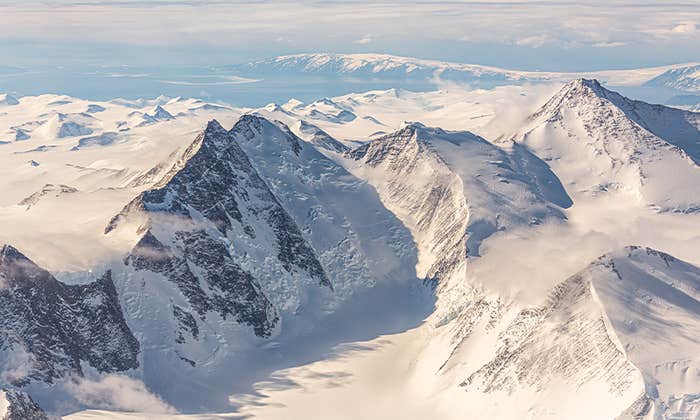The Roman god Jupiter was known for his dalliances with women other than his wife, the goddess Juno. Juno was not fooled, however. Although her husband might cloak himself in a cloud to conceal his activities, Juno developed the ability to see through those clouds and discover Jupiter’s true nature.
It is no wonder that NASA’s current mission to probe beneath planet Jupiter’s cloud cover and discover its true nature is named Juno. Launched from Cape Canaveral, Fla., on Aug. 5, 2011, Juno arrived at Jupiter nearly five years later, having traveled 2.8 billion kilometers, and immediately set about its tasks. The spacecraft has proved more than worthy of its Roman namesake in uncovering Jupiter’s many secrets.
Juno has turned our knowledge of Jupiter “upside down” with its discoveries so far, says Scott Bolton of the Southwest Research Institute in San Antonio, Texas, the mission’s principal investigator. “It’s a whole new Jupiter,” agrees Juno project scientist Steven Levin of NASA’s Jet Propulsion Laboratory (JPL).
Juno is not NASA’s first mission to observe the largest planet in the solar system. In the 1970s, Pioneer 10 and Voyagers 1 and 2 sent back observations made as they flew past Jupiter, as did Ulysses in 1992. From 1995 to 2003, Galileo orbited the planet and probed part way into its atmosphere. In 2007, New Horizons sent back images of Jupiter and its moons Io and Europa, while on its way to Pluto and beyond.
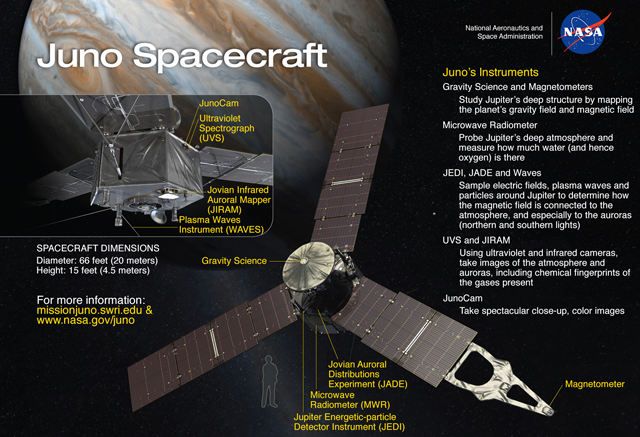
Since the early 1600s, when Galileo Galilei first observed Jupiter, the fifth planet from the sun, we have learned that it is the largest planet in our solar system, 11 times wider than Earth and more than twice as massive as all of the other planets, asteroids and other objects in our solar system combined. The gases and dust that make up Jupiter coalesced 4.5 billion years ago, at about the same time as the other planets in our solar system. As a gas giant, Jupiter lacks a solid surface and consists predominantly of hydrogen and helium, like the sun. It has a thick atmosphere, a massive liquid hydrogen ocean and a core of some sort. But many questions remain. Enter Juno.
Juno—packed with eight science instruments, plus a camera that takes photographs mainly used for public outreach—is currently conducting the most detailed investigation ever of Jupiter’s origin, the composition of its atmosphere, the nature of its core and its role in the creation of the solar system.
Despite an early glitch that threatened the mission, Juno has already achieved remarkable results, say the scientists and engineers who oversee it. And it has much more to uncover in the future. Here are some of the most significant events and findings from the mission so far.
Juno’s Orbit
Juno follows a polar orbit—unlike Galileo, which orbited in Jupiter’s equatorial plane—that is much closer to the planet than that of previous Jupiter-studying spacecraft. The original plan for scientific observation called for Juno to orbit Jupiter 32 times from pole to pole, mapping longitudinal strips as the planet rotated beneath it. The orbits were to take 11 days each, with the mission wrapping up in October 2017. However, while the craft was en route to Jupiter, NASA determined that 14-day orbits, rather than 11, would provide better spacing for the mapmaking.
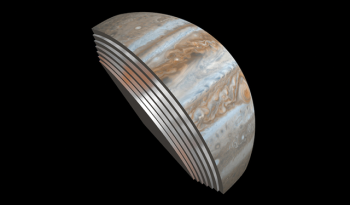
Upon arrival at Jupiter in July 2016, Juno entered an initial 53-day polar orbit as planned. But in October, when the time came to fire the main engine to reduce the orbit to 14 days, one of the fuel valves did not open as intended. Continuing to attempt to fire the engine would have risked an improper fuel mix, which would have put the spacecraft into an undesired orbit, thereby threatening the success of the mission, says Ed Hirst, Juno project manager at JPL.
“We assessed the risk of alternate ways of using the engine to reduce our orbital period, versus the risk of just staying in the 53-day orbit,” Hirst says. The team ultimately decided it wasn’t worth the risk. The mission would continue, still mapping Jupiter through 32 orbits as originally planned—it would just take longer due to the far longer orbital period: Instead of just over a year, it would now take close to five years. As of Dec. 21, 2018, the mission was halfway completed, and it is expected to conclude by late 2021.
Juno’s instruments collect the vast majority of their data within a brief eight-hour window during each orbit—and especially within just three hours of perijove, the spacecraft’s closest approach to Jupiter, about 3,400 kilometers above the planet’s cloud tops. During the rest of the orbital period, the data are sent to Earth, where they are collected by the giant dish antennae of the Deep Space Network (see sidebar below) and relayed to JPL for analysis.
A Thick Atmosphere
All we can see of Jupiter from Earth, even with the most powerful telescopes, are the tops of the highest clouds in its atmosphere. The magnificent colorful bands, the raging storms, the Great Red Spot and all of the other long-lived features we have seen are part of that cloud cover, which is thought to be 71 kilometers thick. It is roughly divided into three layers: a top cloud layer likely composed of ammonia ice, a middle cloud layer of ammonium hydrosulfide crystals, and an innermost layer likely made up of water ice and vapor. Occasionally, the clouds have parted sufficiently to allow scientists to see below the upper level using telescopes. Juno, however, can see through the clouds consistently with a six-channel microwave radiometer.
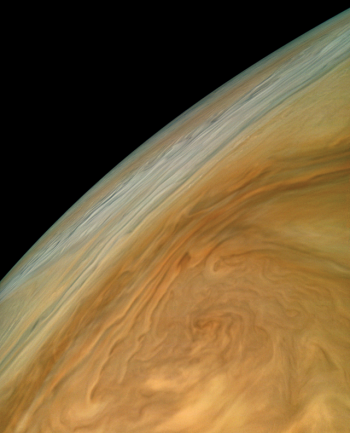
The pressure at Jupiter’s cloud top is about the same as that at the top of Mount Everest (0.5 bar), says Michael Janssen of JPL, the original lead scientist on the microwave experiments who is now retired but continues to work on the project. (One bar is the atmospheric pressure at sea level on Earth.) The pressure increases significantly through Jupiter’s cloud layers all the way to the core, where it cannot yet be measured. Juno’s microwave radiometer can take measurements deep below the clouds, allowing scientists to construct a three-dimensional map of Jupiter’s atmosphere; after all of Juno’s passes, they should be able to stitch together a map of the planet’s entire atmosphere.
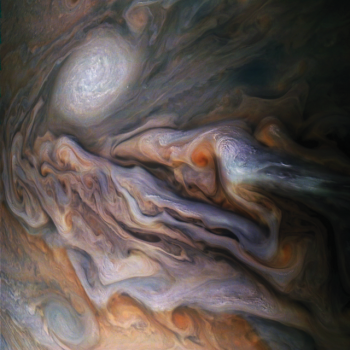
Hydrogen and helium are transparent to most microwave frequencies, so Juno probes for trace gases, especially ammonia, the most abundant, as a proxy to study atmospheric circulation, according to Janssen. Data accumulated during the first half of the mission presented a big surprise to scientists.
“We previously had very limited understanding of ammonia distribution in the atmosphere,” Janssen says. “We thought, based on Earth analogues and modeling, that ammonia was uniformly mixed down to deep levels, with variability only in the uppermost regions, where ammonia clouds form. We discovered that it is actually highly variable over the whole range of pressures.” Jupiter’s ammonia is concentrated in belts within 5 to 10 degrees latitude north and south of the equator and is greatly depleted in other regions. “The fact that this [atmospheric] circulation goes so deep was a surprise to us,” Janssen says.
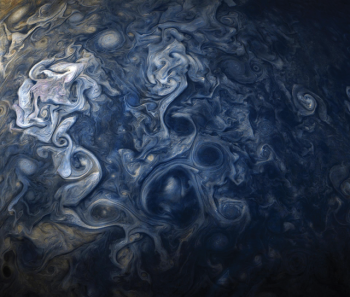
Scientists are also assessing the amount of water in Jupiter’s atmosphere, Janssen says. Water is older than the solar system; it existed in the solar nebula before any planets formed. Hydrogen and helium constituted 99 percent of the nebula, he says, with oxygen a distant third. By studying Jupiter’s water, scientists can learn about the planet’s origin.
“The distribution of water, relative to the distribution on, say, Earth or the inner solar system, tells us [how close to the sun] Jupiter formed,” says Jared Espley, Juno program scientist at NASA. Juno’s repeated measurements with each orbit have already revealed that water in Jupiter’s atmosphere overall is perhaps 10 times as concentrated as it was in the solar nebula, and scientists are expecting to determine that figure more precisely during future orbits. Juno’s microwave radiometer has also detected lightning—which requires water to occur—at atmospheric depths down to 10 bars, providing an additional clue about Jupiter’s origin, Janssen says.
A Confusing Core
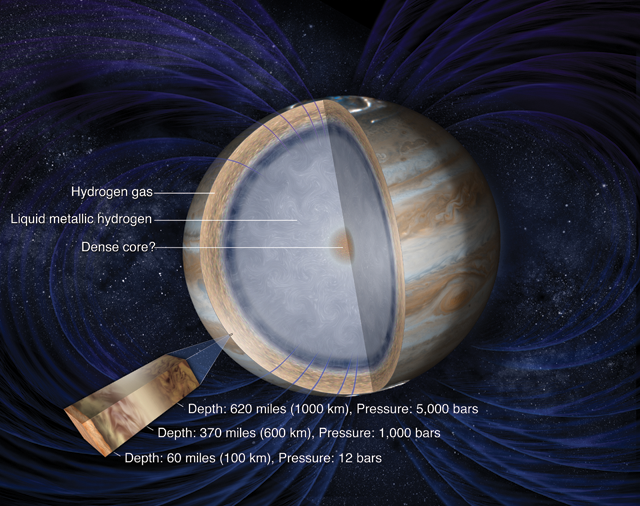
Thanks to Juno, scientists have already gained some new insights into Jupiter’s core. Before this mission, in the absence of detailed data, hypotheses ranged from a core composed of heavy elements solidified early in the solar system to no core at all. If a core indeed exists, as now seems likely, questions remain as to whether it is solid, liquid or both, and whether it is layered or diffuse.
There is no way to investigate the core directly, due to the intense pressures—up to 2 million bars at Jupiter’s center—that would destroy any probe that attempted to reach such depths. Rather, Juno studies the core indirectly by measuring Jupiter’s magnetic and gravitational fields. “By measuring the magnetic field, we are learning about the deep interior,” Levin said during a public lecture in 2018.
The core is still enigmatic, Espley says, but with each orbit, scientists are learning a little more about it.
Gravity measurements also offer clues to the nature of the core. Jupiter rotates completely every 10 Earth hours—so fast that it bulges out at the equator. This affects the gravitational pull on Juno as it zips around the planet, which in turn affects the spacecraft’s speed. By measuring changes in Juno’s speed, scientists can map Jupiter’s gravitational field, leading to conclusions about the size and nature of the core.
Those changes in Juno’s speed, Espley says, also affect the communication signals sent by Juno to Earth. Juno is “pushed or pulled slightly” depending on Jupiter’s distribution of mass, he says. “That push or pull Doppler-shifts the radio signal that’s going back to Earth” to minute extents, offering still more information about the planet’s core. The core is still enigmatic, Espley says, but with each orbit, scientists are learning a little more about it.
At mid-mission, Espley says, the core appears to be large in volume compared to the overall size of the planet, as well as “fairly substantial mass-wise,” suggesting the core is relatively “diffuse.” In other words, unlike Earth’s dense solid and liquid metal ball of a core, it seems that Jupiter’s core is not as condensed and is more spread out.
Asymmetric Magnetism
Another aspect of Jupiter that Juno is discovering to be more complex than anticipated is its magnetic field, which among other features exhibits an unexpected north-south asymmetry. Early orbits by Juno suggested that at least part of the asymmetry is due to magnetic fields generated not only in the core but higher in Jupiter’s atmosphere than scientists had expected, a finding for which the Juno team has, as yet, no explanation, Levin says.
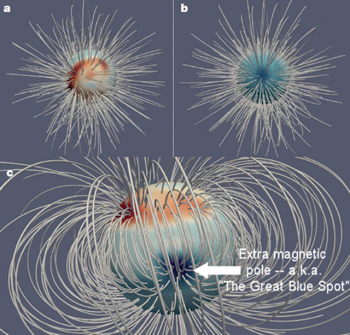
Scientists are also starting to see that, in addition to Jupiter’s large-scale, dipole-like magnetic field, Espley says, the planet also has a lot of small-scale magnetic features scattered around its interior. One large magnetic signature, which Juno has been able to observe courtesy of its close orbit, he notes, arises near the equator, for example.
As Juno passes through Jupiter’s magnetic field lines on each orbit, it measures the particles only in that one spot, but that’s enough to understand and map the entire magnetic field line, Levin says. Magnetic field mapping of rocky planets—even Earth—is limited because of interference from fields generated by those planets’ solid crusts, Espley says, but that is not an issue with crustless Jupiter. Juno will help scientists create the “highest-resolution map of the interior magnetic fields, of dynamos, occurring in a planet in the solar system,” he says. But he expects it will require all 32 science-gathering orbits for scientists to have enough understanding of Jupiter’s magnetic field lines to adequately map the magnetic field.
Storms and More Storms
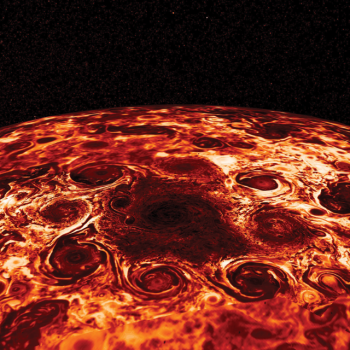
Jupiter’s swirling, colorful appearance is caused by gases rising from the planet’s warmer interior as well as by its strong jet streams and storms. The most distinctive and famous feature of Jupiter is the Great Red Spot, a seemingly permanent storm whose diameter is greater than Earth’s. Juno’s pass over the Great Red Spot revealed that the storm’s rotation extends quite deeply into the atmosphere, down to the 100-bar level at least. “It contains a lot of mass,” Janssen says, which provides great angular momentum, a reason for its stability. It is also, he adds, the area where scientists think more heat escapes from Jupiter’s interior than anywhere else on the planet.
Heat is also upwelling significantly in Jupiter’s equatorial region. Tracing Jupiter’s rising heat is important to Juno scientists, as it drives all atmospheric circulation. “We learned that the Great Red Spot has a stronger temperature gradient than the neighboring atmosphere,” Janssen says. “As heat is driven up, and as the planet rotates, it drives cyclones. Cloud bands are also driven by hot gas rising at different latitudes, through very complex mechanisms we still don’t understand.”
Some of Juno’s most exciting discoveries have come from its observations of Jupiter’s polar regions, because the top-down views of the poles that the spacecraft provides are unlike any images that previous missions and Earth-bound telescopes have offered. The most striking features, completely unknown before Juno, are the clusters of cyclonic storms sitting directly over each pole, Levin says. Five storms circle a central one at the south pole, and eight storms surround one at the north pole. The storms are each thousands of kilometers in diameter, and all rotate in the same direction in close formation, causing strong winds where their outer bands nearly meet. The polar storms have maintained these stable patterns over more than two years of Juno’s observations. Also, Juno has found that the south pole is bluer than the north pole, an intriguing and as yet unexplained phenomenon.
Juno’s Final Years
Although Juno got a de facto extension to 2021 when its 32 science-gathering orbits were stretched to 53 days apiece instead of 14, scientists will likely propose an official mission extension as well, Hirst says. What they would study, Bolton says, is yet to be determined, but “there are a number of science objectives that could be done, because the orbit evolves.” At the beginning of Juno’s mission, the shape of its polar orbit meant that the spacecraft’s perijoves occurred when it was over the equator, but each successive lap shifts the perijove northward by 1 or 2 degrees latitude. “As the orbit changes, new science can be done that wasn’t possible initially,” Bolton says.
When it is Juno’s time to go, the main consideration will be protecting Jupiter’s moons, especially Europa, from any contamination.
Juno’s finale is set to be similar to Cassini’s end at Saturn: Scientists will direct Juno to fire its thrusters one last time and plunge into Jupiter’s atmosphere, where it will collect and transmit as much data as it can before the planet’s extreme conditions crush or incinerate the spacecraft and its instruments.
When it is Juno’s time to go, the main consideration will be protecting Jupiter’s moons, especially Europa, from any contamination. NASA’s planetary protection protocols require that Europa remain pristine until the Europa Clipper mission launches in the 2020s. It will orbit Jupiter and regularly fly by Europa, coming as close as 25 kilometers above its surface, to investigate the moon’s presumed subsurface ocean and any life it may contain.
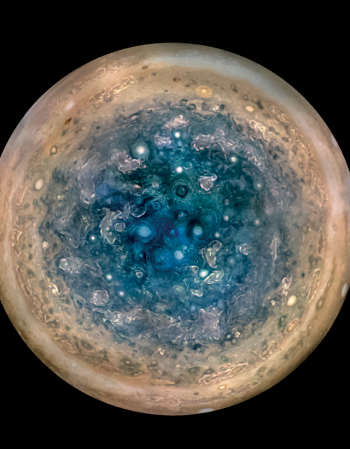
As for Juno’s legacy, one thing the mission has taught researchers is that “when you really get up close and personal with a planet, even one that you have explored before and thought you understood, you can be really surprised in many, many ways,” Bolton says. “I don’t think anybody anticipated or expected that Juno was going to turn Jupiter upside down in our understanding,” but it has. “That’s a lesson for us in exploring the rest of the planets in our solar system,” Bolton adds. “We thought we understood giant planets, but it’s clear that we didn’t.”
Lead image: Over the last few decades, we have come to know Jupiter from thousands of Hubble Space Telescope images such as this one. Now, Juno is providing unprecedented new views of the planet and revealing secrets about the Great Red Spot (lower left), the other storms and swirling clouds at the top of the planet’s atmosphere, and many features far below. Credit: NASA, ESA, and A. Simon (NASA Goddard).
This article was originally published in Earth Magazine on March 11, 2019.


























